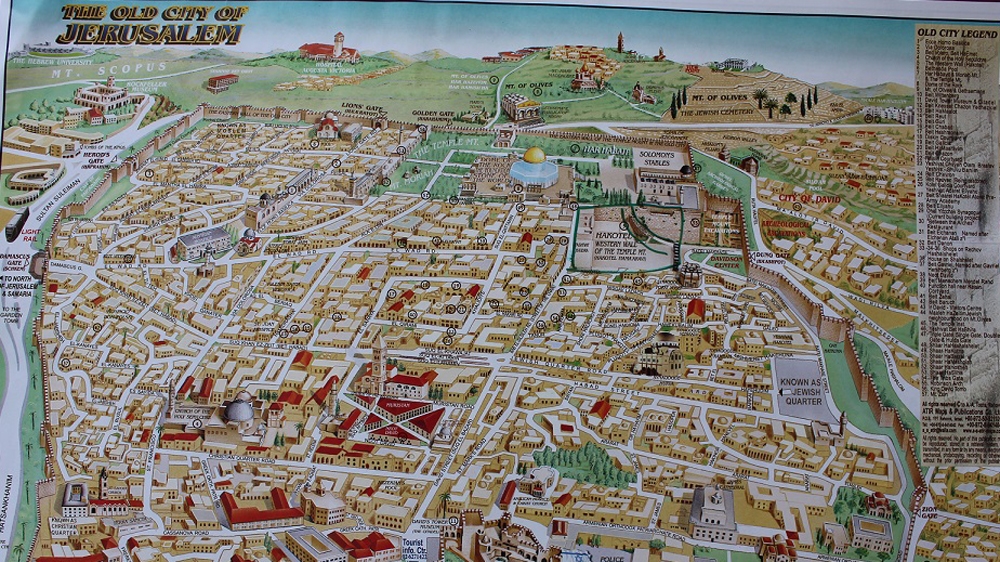Israel Removes Palestinians,Christians From Jerusalem Map,Promotes Blond Haired 'King David' Disney-like Theme Park On Occuppied Palestine Land Instead !
Israel removes key sites from Jerusalem's Old City Map
Israeli ministry's map of Jerusalem's Old City marks historically unimportant sites and omits key non-Jewish holy sites.
![Israel removes key sites from Jerusalem's Old City Map The Israeli tourism ministry's official Old City map erases important Muslim and Christian holy sites and entire neighbourhoods around the historic basin [Harvey Meston/Getty Images]](http://www.aljazeera.com/mritems/imagecache/mbdxxlarge/mritems/Images/2016/6/8/cacab653f648483687c7b6e1da61a52c_18.jpg)
Jerusalem - In groups of twos, threes and families, visitors shuffled towards the ticket booth at the City of David archaeological park. Sunscreen was reapplied, mineral water sipped, and shekels exchanged for paper tickets.
It is a typical touristic scene that plays out thousands of times daily across Jerusalem. But the City of David park, located in the heart of a Palestinian neighbourhood in East Jerusalem, is not a regular attraction.
It is a touristic settlement managed by Elad, a private political organisation that facilitates the purchase and takeover of Palestinian homes in the Old City and occupied East Jerusalem in an effort to increase Jewish settlement.
The City of David site features prominently, in large, bold red letters, on the Israeli tourism ministry's official Old City map, which is distributed free of charge at official tourist information centres in Jerusalem.
But the nearby al-Haram al-Sharif, or the Noble Sanctuary, a 14-hectare compound that comprises Islam's third holiest site, al-Aqsa Mosque, as well as the Dome of the Rock, is only referred to by its Jewish name: the Temple Mount.
Although these major tourist attractions have always been promoted in most touristic literature about Jerusalem, al-Aqsa Mosque is illustrated on the official Old City map - albeit anonymous - while the Dome of the Rock is mentioned. Meanwhile, dozens of sites of questionable historical importance, many of them Jewish settlements in the Muslim and Christian quarters of the Old City, are highlighted by the mapmakers in an "Old City Legend" numbered guide.
 |
| The map labels dozens of historically unimportant sites while omitting key non-Jewish holy sites in its 'Old City Legend' key [Nigel Wilson/Al Jazeera] |
Among 57 numbered sites, almost half are buildings occupied by Jews in the Muslim quarter of the city, many unknown to licensed tour guides. A number of yeshivas, Jewish religious schools, as well as synagogues purchased by Jews in the Muslim quarter of the Old City, are managed by the Ateret Cohanim organisation, a right-wing nonprofit organisation that seeks to replace Palestinian residents of the city with Jewish-Israeli settlers.
Like Elad, Ateret Cohanim is a nationalistic settler group. In recent years, it has pursued a legal campaign to evict Palestinian families from their homes in the Old City in order to replace them with Jewish families.
"There are a bunch of sites that are not only historically unimportant, but that are run by settlers," said Betty Herschman, director of international relations and advocacy at Ir Amim, an Israeli human rights NGO that gives tours of East Jerusalem to diplomats and other parties.
"That is to the detriment of historically relevant Christian and Muslim sites, which you would think would be far more prioritised on a map of the Old City, the hub of the three major monotheistic religions."
One licensed Jerusalem tourist guide, who did not want to disclose his name, noted that the map favoured Jewish sites regardless of their touristic value and appeared religiously skewed.
This map, in addition to erasing important Muslim and Christian holy sites in the Old City, completely erases entire neighbourhoods around the historic basin, supplanting them not only with Hebrew names but with the names of settlements.
|
"When I saw it, I thought it was a map for only Jewish tour groups," he told Al Jazeera, surprised to learn that it was being distributed at the main tourist information centre by Jaffa gate. "The narrative it shows is quite exclusive to one religious group."
While buildings like Beit Wittenberg, Beit Danon and Beit Eliyahu feature among the list of 57 sites, there is no room on the list of the numbered sites for the Church of St Anne or the Church of the Redeemer, although the latter is on the map with a tiny, hard to find name.
Aziz Abu Sarah, a Jerusalemite who cofounded Mejdi Tours, told Al Jazeera that the exceptions do not make sense from a business perspective. "I think that a lot of Israeli tour operators and tour guides, even right-wingers, would agree with me that a touristic map should show the treasures of the city," said Abu Sarah.
"I grew up in Jerusalem. St Anne's Church, which I think is one of the most amazing places, is not on the map. There are many Christians coming to Jerusalem, and they are going to get a map that doesn't identify their holy sites. It's not a smart decision."
The Israeli Ministry of Tourism defended the map when contacted by Al Jazeera. "The map, which was produced in cooperation with tour guides and took into account their recommendations and the vast knowledge they have accumulated, is useful and convenient, listing the main tourist sites," the ministry said in a statement.
However, Abu Sarah suggested that the inclusion of certain sites inside and outside the Old City walls seemed to promote a Jewish nationalistic representation of East Jerusalem.
"Politically speaking, it adds sites that are controversial, like the settlements in East Jerusalem, and I think that makes it political and one-sided. In many ways, there is a national narrative, and perhaps this is where the national narrative is going."
Indeed, the Palestinian neighbourhoods outside the Old City walls are absent on the map, apart from Ras al-Amud, while Jewish-only settlements built in those neighbourhoods are represented.
The City of David is easily spotted, but the neighbourhood of Silwan that surrounds it is not labelled. Palestinian communities, including At-Tur, Wadi al-Joz and Issawiya do not appear, but the settlement of Maale Har Hazeitim is labelled with the Star of David.
"This map, in addition to erasing important Muslim and Christian holy sites in the Old City, completely erases entire neighbourhoods around the historic basin, supplanting them not only with Hebrew names but with the names of settlements," Herschman told Al Jazeera.
These settlements, added Herschman, are built by radical settlers within the heart of Palestinian neighbourhoods; namely, Bet Orot, a community of 150 settlers living in the Palestinian neighbourhood of At-Tur, that does not even appear on the map.
Maintaining the Palestinian identity of East Jerusalem is a crucial plank in the "two-state solution" to the Israeli-Palestinian impasse as the neighbourhoods would form the capital of a future Palestinian state. In this context, the settlements are seen as an attempt to disrupt Palestinian territorial contiguity in East Jerusalem in order to ruin Palestinian plans to have East Jerusalem as its capital city.
"The map is legitimising private settlement around the historic basin," Herschman told Al Jazeera.
"This is a form of consolidating Israeli control of arguably the epicentre of the most critical point of Jerusalem - which is itself the epicentre of the Palestinian-Israeli conflict. So there are extremely important political consequences involved."

No comments:
Post a Comment